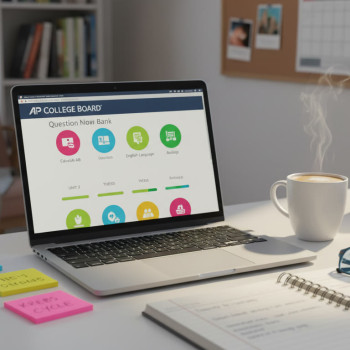Why start thinking about AP in MYP 1–5? — A friendly reality check
Imagine a river: on one side, the International Baccalaureate Middle Years Programme (MYP) emphasizes conceptual understanding, interdisciplinary learning, and learner profiles. On the other side, Advanced Placement (AP) courses assess subject-specific depth and exam technique that can earn you college credit. The good news? The river isn’t as wide as it looks. Starting in MYP 1 and intentionally building certain habits across MYP 1–5 creates a bridge — one that makes the jump into AP not only possible, but confidently achievable.
This article is for students and parents who want a practical, compassionate roadmap: how to recognize transferable skills in the MYP, what to practice differently, and how to use targeted support (including personalized tutoring like Sparkl’s 1-on-1 guidance and tailored study plans) to make the transition smooth and effective.
Big-picture alignment: What MYP gives you that helps in AP
MYP and AP aren’t opposites — they’re complementary. MYP’s strengths (critical inquiry, unit-based projects, formative reflection, interdisciplinary thinking) give you durable learning skills. AP will ask you to apply those skills in a different shape: rigorous content knowledge, precise exam writing, timed pacing, and often higher-stakes assessment.
Here are the essential MYP-to-AP bridges:
- Conceptual thinking → Applied content mastery: MYP teaches depth of understanding; AP requires applying that depth to specific topics and types of questions.
- Inquiry and projects → Focused synthesis: MYP projects promote research and presentation skills; AP exams require focused synthesis—clear argument, evidence, and discipline-specific language.
- Formative assessment → Exam strategy: MYP’s diverse assessment formats build resilience; the missing piece for AP is explicit exam technique and timed practice.
- Interdisciplinary learning → Transferable reasoning: MYP encourages cross-subject thinking; AP benefits when students can bring reasoning skills from one context to another (e.g., using math logic in AP Physics).
Skill development by MYP year: A practical guide
If you’re a parent or student reading this during MYP 1, 2, 3, 4, or 5, here’s a targeted checklist that grows each year. The goal is cumulative: small, consistent habits that become second nature before you pick up that first AP textbook.
MYP 1–2: Foundations — Curiosity, organization, and literacy
- Build reading stamina: 30–45 minutes of varied reading (science articles, historical narratives, literary short stories) three times a week.
- Practice note-taking routines: Cornell notes, margin summaries, and a 3-sentence daily recap to consolidate learning.
- Introduce timed short responses: 10–15 minute prompts asking for a clear claim plus two supporting sentences.
- Start a simple portfolio: keep one folder (digital or physical) of strongest work to review growth each term.
MYP 3–4: Deepening — Argumentation, evidence, and quantitative fluency
- Work on constructing arguments: claim, evidence, explanation. Aim for clarity over complexity.
- Practice data interpretation: charts, graphs, and simple statistics (mean, median, mode) across sciences and humanities.
- Start low-stakes mock exams: one short, timed exam per term to build pacing and reduce test anxiety.
- Refine research skills: credible sources, paraphrasing, and synthesizing multiple references into a coherent paragraph.
MYP 5: Readiness — Exam mindset, synthesis, and purposeful revision
- Simulate AP question types in subject areas you plan to take: multiple-choice timing, short-answer defense, document-based questioning.
- Develop a revision cycle: spaced review, interleaving topics, and focused study blocks with active recall.
- Practice higher-end writing: thesis-driven essays, using evidence and subject-specific terminology.
Practical weekly routine for MYP students aiming for AP later
Consistency beats cramming. Here’s a weekly plan parents and students can adapt. It’s built around six pillars: reading, writing, problem solving, review, testing, and reflection.
| Activity | Time (weekly) | Purpose |
|---|---|---|
| Focused reading (diverse genres) | 3 × 45 min | Build discipline-specific vocabulary and stamina |
| Argument writing / short responses | 2 × 30 min | Practice clarity, evidence use, and concise expression |
| Problem solving (math/science) | 3 × 45 min | Strengthen procedural fluency and reasoning |
| Weekly review (spaced practice) | 2 × 30 min | Long-term retention of earlier units |
| Timed practice questions | 1 × 60 min | Develop exam pacing and reduce anxiety |
| Reflection & planning | 1 × 20 min | Self-assessment and goal-setting |
How to map MYP assessments to AP expectations
MYP assessments often emphasize criteria-based rubrics (knowledge, skills, communication, reflection). AP focuses on content mastery and assessment tasks that are tightly aligned with course objectives (e.g., AP Biology, AP Calculus, AP World History). Translating one into the other means making assessment criteria explicit for students:
- Turn MYP criterion descriptors into AP-style success checks (e.g., “Use evidence to support a claim” → practice with AP-style short answers and document-based prompts).
- Create rubrics that borrow AP language: “Thesis/Claim,” “Use of Evidence,” “Correct Application of Concepts.”
- Use MYP projects to build long-form skills (research, synthesis) and then practice condensing that skill into AP-friendly formats (timed essays, structured problem sets).
Sample mini-curriculum: MYP 4 to MYP 5 targeted plan for AP readiness
Below is a focused 12-month sample curriculum for a student finishing MYP 4 and heading into MYP 5 who intends to take AP classes in Grade 11 or 12. The plan balances content, skill work, and test technique.
- Months 1–3: Diagnostic and foundations — identify strengths/gaps with one-on-one review sessions; set specific targets (e.g., algebra fluency, historical document analysis).
- Months 4–6: Skill stacks — practice short-answer writing, data interpretation, and timed multiple-choice sessions; integrate reading into content study.
- Months 7–9: Applied depth — tackle AP introductory units in chosen subjects, alternating deep study weeks with mixed-content review weeks.
- Months 10–12: Consolidation and simulated exams — full timed practice exams, targeted review sessions, and stress-management strategies.
Where personalized tutoring (and Sparkl) fits in — smart support, not just more hours
Not every student needs tutoring, but the right kind of tutoring accelerates progress dramatically. Personalized tutors help translate MYP strengths into AP advantages by:
- Creating tailored study plans that fit each student’s learning profile and school workload.
- Offering 1-on-1 guidance to fix misunderstandings quickly and model AP-style thinking.
- Providing expert feedback on practice essays and timed responses so students see exactly how to improve.
Sparkl’s personalized tutoring can be particularly useful when the goal is specific: for example, an MYP 5 student who needs high-quality practice on AP-style short responses or a focused revision plan that uses AI-driven insights to target weak spots. The difference between generalized help and targeted, evidence-based tutoring is measurable: you practice the right things at the right time.
Concrete strategies that make the bridge real
Here are research-aligned, classroom-proven strategies your family can implement right away.
1. Active recall + spaced repetition
Move beyond rereading. Make flashcards with a question on one side and a concise, evidence-based answer on the other. Schedule reviews using spaced intervals — the goal is automatic retrieval, which cuts study time and improves long-term memory.
2. Past-question practice and deconstruction
Practice with AP-style questions and then deconstruct every answer. Ask: what evidence was used? How was the argument structured? What specific content was assumed? Deconstruction turns score-chasing into strategy development.
3. Timed writing and the three-paragraph warm-up
Train for clarity under time by writing a three-paragraph essay in 30 minutes: introduction with thesis, two evidence paragraphs, and a one-sentence conclusion. Grow complexity and depth gradually until full-length AP essays are comfortable.
4. Integrate math-science reasoning into humanities and vice versa
AP success often rewards cross-domain thinking. Use data from science labs to support claims in a history mini-project, or apply logical structuring from math proofs to organize complex argumentative essays.
5. Feedback loops and deliberate practice
Frequent, specific feedback is the engine of improvement. Whether from a teacher, a peer review, or a tutor, feedback should point to one or two concrete actions the student will take before the next practice attempt.
Common parent and student questions (with straightforward answers)
- When should my child start AP prep? Ideally by MYP 4 for students aiming to take multiple APs in Grades 11–12. Earlier preparation (MYP 1–3) focuses on habits and literacy rather than content.
- How many APs should a student take? Quality over quantity. Start with one or two aligned to strengths and college goals, then add more if workload and mastery allow.
- Can MYP students earn college credit through AP? Yes — AP exams can translate into college credit depending on exam scores and university policies. AP readiness should therefore include exam technique, not just course content.
Sample comparison table: MYP skill versus AP demand
| MYP Skill / Practice | AP Demand | How to Bridge (Actionable) |
|---|---|---|
| Interdisciplinary projects | Subject-specific synthesis under time | Extract subject-specific claims from projects and practice condensing them into timed essays |
| Criterion-based formative feedback | High-stakes single-exam scoring | Translate criteria into AP rubric items and run mini-mocks |
| Inquiry-led research | Precise evidence-based responses | Practice short-answer evidence use and document-based question techniques |
| Reflective learner profile attributes | Metacognitive test strategies | Teach active planning, monitoring, and review during timed practice |
Assessment calendar — what to prioritize each term
Below is a compact calendar suggestion (adapt to your school’s calendar):
- Term 1: Diagnostic assessments + reading and note-taking foundation work.
- Term 2: Short-answer and data interpretation practice; introduce timed 30–45 minute tasks.
- Term 3: Full-length practice in one chosen subject; focus on pacing and evidence use.
- Term 4: Consolidation with mixed practice; end-of-year review and targeted tutoring where needed.
Real-world examples: Two student profiles
These composite profiles show how MYP students can diverge into AP tracks based on interest and support.
- Sofia — The Humanities Deep Diver: Strong MYP language and global contexts; starts timed DBQ practice in MYP 4, adds AP World History in Grade 11. Uses Sparkl’s 1-on-1 tutoring for targeted essay feedback and builds a vocabulary log for historical terms.
- Liam — The STEM Integrator: Excels in MYP design and sciences; spends MYP 3–5 practicing data interpretation and calculus readiness. Takes AP Calculus and AP Physics, using tailored problem-sets and a weekly review cycle with a tutor to strengthen weak sub-skills.
Practical checklist before taking your first AP
- Can you summarize a topic in 2–3 clear sentences and support it with 2 pieces of evidence?
- Have you completed at least three timed practice questions in the AP format for that subject?
- Do you have a revision plan with spaced intervals and a prioritized list of weak topics?
- Is there an accountability system — tutor, teacher, or study partner — to check progress weekly?
Final thoughts — Bridge building as growth, not pressure
The best bridge from MYP to AP isn’t built overnight or from anxiety. It’s constructed brick by brick — habits, clarity, deliberate practice, and the occasional expert nudge. For many families, targeted, personalized tutoring (like Sparkl’s tailored plans and expert tutors) provides that nudge: a way to turn MYP strengths into AP-ready skills without overwhelming the student.
Remember: success in AP is not just about scoring well on a test. It’s about developing habits that support college-level thinking — clear expression, robust evidence, time management, and the confidence to apply knowledge under pressure. Start small, practice deliberately, and treat each MYP year as an opportunity to add another stone to your bridge.

Ready to start? Pick one skill from the weekly routine, practice it for 4 weeks, and reflect on progress. If you want structure, consider a short, targeted tutoring plan to accelerate the bridge. With steady effort and smart support, AP readiness from MYP 1–5 becomes not just possible, but a natural step in a student’s learning journey.




















No Comments
Leave a comment Cancel